
16 minute read
2nd City Brigade – 20th – 22nd Battalions
20th, 21st and 22nd Manchesters trained in Morecambe, Belton Park and Larkhill Camp. They formed 91st Brigade of 30th Division when they also disembarked in France in November 1915. In common with the other Pals Battalions, they were reorganised in December 1915 when 91st Brigade was moved to 7th Division. 20th Battalion was also transferred to 22nd Brigade, within 7th Division.
Private 19623 Valentine Rowe enlisted in 21st Battalion and trained in XV of D Company. He joined the BEF with the Battalion in France on 10 November 1915. He had previously worked for Manchester Corporation’s electricity department. Fighting though the Battle of the Somme, 21st Battalion moved to the Italian Front in November 1917, returning to France in September 1918.
Advertisement
Returning to England in 1919, Valentine was on demobilisation furlough when he passed away on 4 February 1919. Valentine died from pneumonia, aged 37. He was buried in Manchester (Phillips Park) Cemetery Valentine’s widow, Margaret Ann, and two sons lived at 177 Prince St, Ardwick. No headstone could be identified on the burial.
Originally enlisting on 14 August 1915, Private 25609 Frederick Graham (aka Dawson) trained with 27th Reserve Battalion.
Presumably having previous military experience, Frederick was quickly prepared for front line duty and he had transferred to 22nd Battalion when it arrived in France on 11 November 1915. Frederick was wounded at Mametz on 1st July 1916 and evacuated home on 5th July. Frederick deserted from January 1917 to February 1918. He returned to the army and was discharged in June 1918.
Frederick Graham died from TB attributed to service in Salford Union Infirmary on 8 March 1919, aged 24. He was buried in a common grave at Salford (Weaste) Cemetery
Frederick’s widow, Ethel, lived at 104 Princes Road, Liverpool. His father, Frederick Dawson, had died in 1901. Frederick Junior’s mother, Margaret, had re-married a Mr Graham and her children adopted his family name.
Private 55044 Arthur Cole had enlisted in the Northamptonshire Yeomanry on 16 November 1914. Disembarking with the BEF on 12 November 1917, Arthur was transferred to 21st Battalion four days later and moved to Italy soon after. Appointed lance corporal, Arthur was posted to 22nd Battalion in September 1918. He was wounded in October 1918 and returned home in February 1919. Arthur was discharged on 28 February 1919.
Arthur died from TB attributed to service and meningitis on 19 January 1920, aged 24. He passed away at his Uncle James’ home at 18 Regent Street, Wellingborough. His parents, Priscilla and John Ambrose Cole, lived at 30 Winstanley Street, Wellingborough. Their younger son, Frank, had been killed in 1918 serving with 5th Northants. Arthur is buried in an unmarked plot in Wellingborough (Doddington Road) Cemetery.
Private 75099 Tom Bowerbank served overseas with 20th Battalion after 1915. He was discharged on 1 March 1919 with a pension for disorderly action of the heart that was aggavated by service.
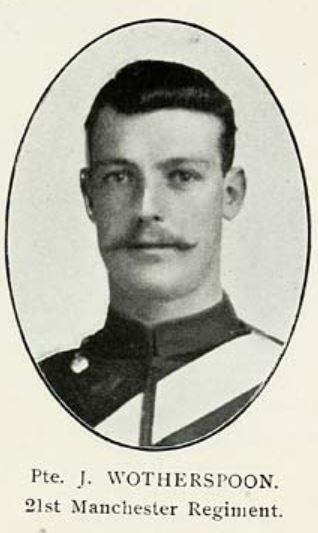
Tom Bowerbank died from tachycardia and epithelium of the groin. He was the husband of Charlotte Bowerbank of 428 Rochdale Road, Oldham. In civilian life Tom was a cotton mule spinner. He is buried in an unmarked plot at Oldham Chadderton Cemetery.
Private 19656 James Wotherspoon enlisted in 21st Battalion on 5th January 1915 and trained with XI Platoon. Prior to hostilities he worked in the packing department of William Graham & Co and he had previously served twelve years with the 9th Lancers, including the Boer War. It is anticipated James may have been transferred to 26th (Reserve) Battalion before 21st Battalion embarked for France. He was discharged on 7 January 1916.
James died from aortic incompetence aggravated by service on 18 May 1917, aged 47. He was buried at Manchester Southern Cemetery.
No headstone could be identified on the burial. James’ widow, Mary Ann, daughter and four surviving children from his previous marriage lived at 88 Morton Street, West Gorton. He was the son of James and Margaret Wotherspoon. His brother, Edwin, died in on 21 November 1918 serving with the Army Service Corps.
Private 21278 Henry Osborne had been a fruit hawker when he enlisted in 22nd Battalion on 11 January 1915. Serving in E Company for a little longer than a month, Henry was discharged at Morecambe on 15 February 1915.
Henry died from TB on 14 November 1919, aged 38. Henry was buried at Manchester Southern Cemetery. No headstone could be identified on the burial. His widow, Edith, and two children lived at 15 Holgate Street, Medlock Street, Hulme. Thirty five days is a very limited period of service and Henry’s death four and half years later would seem somewhat remote. However, as pension records confirm Henry’s TB had been aggravated by service and as TB was his cause of death, he meets the criteria for commemoration.
Private 49236 John Joseph Conroy had been an Architects Draughtsman when he attested under the Derby Scheme on 5 December 1915. He was mobilised 8 December 1916 and served overseas with 22nd Battalion from 5 February 1917 to 10 October 1917. John was discharged from Depot at Preston on 30 August 1918. He had been treated for shell shock after being blown up and buried at Bullecourt. John received a pension for Neurasthenia.
John Conroy died from pneumonia and shell shock on 6 June 1919, aged 21. He is buried Liverpool (Yew Tree) Roman Catholic Cemetery. He was the son of the late John Conroy and Monica Conroy of 61 Hall Lane, Liverpool.

Francis died from mitral VDH due to service on 31 August 1921. This was the last date for qualification as a War Grave and Francis will be the Regiment’s final casualty of the Great War, if his adjudication is accepted. Francis was the husband of Mary Jane Patchett of 95 Osborne St, Oldham Road, Manchester. He had two sons from a previous marriage. Their mother had been Winifred Patchett. No burial has been identified for Francis. He died at Ancoats Hospital Convalescent Home, Great Warford, Cheshire. Commemorated in UKBOR 17/12/2022
23rd (Bantams) Battalion
8th City or 23rd (Bantams) Battalion trained in Manchester, Morecambe, Masham and Salisbury Plain, prior to embarking for France in January 1916. Originally recruiting men who were below the minimum military height requirement, this limitation was removed in early 1917. They remained on the Western Front until the Battalion was disbanded in February 1918.
Private 22082
Francis Alfred Patchett had been a moulder’s labourer when he enlisted in 23rd Battalion on 30 November 1914. During training, Francis was appointed lance corporal, but later reverted to private. Francis returned home prior to his discharge on 21 August 1917.
Private 22799 Arthur McLay had been a fitter when he enlisted in 23rd Battalion on 5 January 1915. He joined the BEF with the Bantams on 29 January 1916. as part of the Machine Gun Section. Arthur was partially buried at Guillemont on 23 July and evacuated home on HS St Denis on 27 July 1916. He was treated at King George Hospital, London and discharged unfit on 21 October 1916.
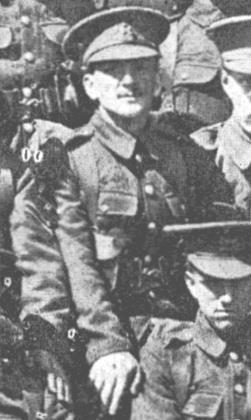
Arthur McLay died on 8 April 1917, aged 21. He is buried at Clayton (St Cross) Churchyard. The son of John Thompson & Jane McLay of 689 Ashton New Road, Clayton. He received a SWB and pension. CWGC accepted this commemoration today. We don’t have the DC but assume Arthur died from nephritis. Research credit to Stanley Laing. Commemorated in UKBOR 15/12/2022
Sergeant 23896 Ernest Royle had been a Master shoe maker when he enlisted in the Bantams on 22 May 1915 and promoted to Sergeant on the same day. He disembarked in France with 23rd Battalion on 29 January 1916 and served overseas until he was evacuated due to sickness on 7 February 1917. Ernest was discharged due to VDH on 26 February 1917.
Ernest Royle died from Valvular Heart Disease aggravated by service and pleurisy on 2 September 1919, aged 40. He was the husband of Florence Ethel Royle of 4 Narbuth Street, Halliwell Lane, Cheetham Hill. The couple had four children. Ernest has a legible headstone at Manchester Southern Cemetery. Commemorated in UKBOR 17/12/2022 commemorative headstone. The son of Emily and Thomas Kent of 293 Moss Lane East. Moss Side Commemoration approved in UKBOR 23/11/2022
Private 38697 John Ashworth was probably another Derby Scheme man when he enlisted in 23rd Battalion on 12 December 1915. He has previously been a mule piecer in a cotton mill and was posted overseas with 23rd Battalion, but later transferred to 2nd Battalion. John was discharged unfit on 31 July 1918.
John Ashworth died from TB attributed to service on 30 May 1920, aged 30. He is buried in an unmarked plot at Oldham (Chadderton) Cemetery. John was the son of Robert and Mary Ashworth of 47 Featherstall Lane, Oldham. Commemoration approved in UKBOR 05/11/2022


24th (Oldham Comrades) Battalion
Private 4066 Tom Roland Kent had been a shipping clerk when he enlisted in 7th Battalion on 9 June 1915. Discharged with TB, Roland re-enlisted in 8th Battalion and served overseas ‘47482’ with 23rd Battalion in 1917. He was re-diagnosed with TB and evacuated home after two months with the BEF. Roland was discharged on 11 April 1917.
T. Roland Kent died from TB due to service on 26 April 1918, aged 30. He was cremated at Manchester Crematorium where he has a
24th Battalion trained at Llanfairfechan, Belton Park and Larkhill. They formed part of 91st Brigade with 20th – 22nd Battalions when they disembarked in France in November 1915. A month later 24th Battalion was transferred to 22nd Brigade and redesignated as a pioneer battalion with 7th Division on May 1916 with which they moved to Italy in November 1917.
Lance Corporal 14142 George Ernest Taylor enlisted in 24th Battalion on 10 November 1914 and trained in III Platoon of A Company when he was promoted to corporal. Also serving throughout hostilities in France and Italy, George returned to England in January 1919 and he was transferred to reserve as lance corporal on 22 February 1919.
George Taylor died from TB attributed to service on 20 October 1920, aged 23. He is buried at Barton Upon Irwell (St Catherine) Churchyard. The minimum age for overseas service was 19, although George was still 18 years old when he joined the BEF. He had enlisted at the age of 17 and was one of the youngest soldiers who served overseas in our current group of unforgotten casualties George was the son of Samuel and Catherine Taylor of 46 Crystal Road, Blackpool. Prior to hostilities, George had worked as a fitter and lived at 83 Manchester Street, Oldham. Commemoration approved in UKBOR 05/11/2022
Sergeant 14116 John Moss Cowley had been a paviour prior to enlisting in 24th Battalion on 9 November 1914. He had previously served in the Lancs Fusils. John was posted to 27th Battalion in August 1915 and joined the BEF as Sergeant with 2nd Battalion on 12 November1916. He was posted to Depot in 1917 and returned to 2nd Battalion in April 1918. John was posted to Depot later that month and discharged with Pension in September 1919.

John Cowley died from VDH due to service on 23 February 1920, aged 45. The husband of Mary Cowley of 3 Prince Street, Rhodes Bank, Oldham.
Private 14176 Charles Smith was a beef butcher when he enlisted in 24th Battalion on 12 November 1914. He trained with 4 Pln. and was appointed paid Acting Lance Corporal on 01/02/1915. Charles disembarked in
France on 8 November 1915 and was granted two weeks Home leave from Italy in April 1917. Charles returned to England in February 1919 and he was demobilised on 22/03/1919. He re-enlisted in the Royal Navy ‘SS/124290’ on 07/08/1919 served as a Stoker 1st Class on board HMS Columbine and Wryneck.
Charles Smith was admitted to Edinburgh Fever Hospital and died from septicaemia on 16 April 1921. Charles was buried in an unmarked plot at Oldham (Chadderton) Cemetery. He was the son of Adam and the late Elizabeth Smith of 26 Manchester Road, Werneth, Oldham. Credit to IFCP research.
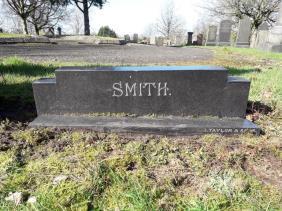
Lance Corporal 14730 Thomas Kelly had been a steel spindle maker when he enlisted in 24th Battalion on 15 December 1914. He trained with XI Platoon of C Company. Thomas disembarked with the Battalion in November and served with the Oldham Comrades until he was transferred to reserve in March 1919. Lance Corporal Kelly received an army pension for TB attributable to his service.
Thomas Kelly died from TB at his home on 17 February 1920, aged 23. He was buried at Moston (St. Joseph's) Roman Catholic a Pension on 19 February 1919, he became manager of the Coffee Hall, Bull Ring, Grimsby.
Cemetery His widow, Elizabeth Kelly, lived at 204 Radcliffe Road, Oldham.
Private 14988 Edward Hulme also joined the BEF with 24th Battalion, having enlisted on 11 January 1915. Edward trained in XVI Platoon of D Company and he was subsequently transferred to 22nd and 11th Battalions before returning Home in March 1918. Edward deserted for more than twelve months from January 1917 and he was discharged unfit on 18 June 1918.
Harold Hobson died from Ulcerative Endocarditis due to service at 24 Bull Ring, on 28/11/1920, aged 24. His Widow Mrs E Hobson lived at Bull Ring. Harold was the son of William & Elizabeth Hobson of 57 Chadderton Road, Oldham
25th-27th (Reserve) & Training Battalions
Edward Hulme died from TB on 16 April 1921. He was buried in an unmarked plot at Oldham (Greenacres) Cemetery. Edward was the husband of Martha Ann and father of Elizabeth Hulme of 5 Brunswick Street, Oldham.
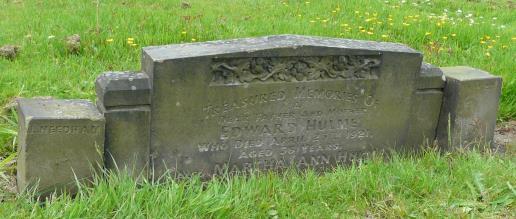
Lance Corporal Harold Hobson had been a spinner in a cotton mill when he enlisted in 24th Battalion on 16 January 1915 and trained in XVI Pln of D Coy. He disembarked in France with 24th Bn in November and was appointed unpaid Lance Corporal in February 1916. He was wounded and posted home to Depot on March 1916 and 27th (Reserve) Bn that April, after Furlough. Harold returned to France posted to 19th Battalion in August 1916 and awarded the Military Medal for throwing an ignited bomb out of a sap on 4 December 1916. He was evacuated home with wounds, with treatment at the Welsh Metropolitan War Hosp, Cardiff. Posted to Command Depot in August 1917 after 4 weeks furlough, Harold was transferred to 3rd Battalion on 19 September 1917. Transferred to reserve with
In the first few months of 1915, the City Battalions recruited a fifth “E Company” as a reserve for future reinforcements. In contrast to original recruitment of clerks and warehousemen, E Company men arrived from all walks of life, including labourers, miners and policeman. The existing City Battalion men found these additions to be very useful constituents in their units. By September 1915, the City Battalions moved to Lark Hill. At this stage, men who were unprepared for the rigours of the final overseas training or service were transferred to newly formed Reserve Battalions. Recent and subsequent recruits then joined the Reserve Battalions from the Depot.
25th and 26th Battalion was formed from 1st and 2nd City Brigades and 27th Battalion was formed from 22nd , 23rd and 24th Battalions. All three Battalions moved from their depots to Prees Heath and subsequently Altcar.
Private 10268 Frederick Charles Wilson had been a butcher when he enlisted in 18th Battalion on 5 September 1914. He trained with VIII Platoon of B Company and was employed as a camp butcher at Heaton Park. Frederick was transferred to 25th Battalion on 30 August and discharged from Press Heath on 26 November 1915.
Frederick Wilson died from TB aggravated by service on 5 July 1919, aged 25. He is buried at Stoke-on-Trent (Hanley) Cemetery. His parents were Edward William Worth and Sarah Jane Wilson of 4 Whitmore Street, Hanley, Staffs. Commemoration approved in UKBOR 05/11/2022.
6th Volunteer Battalion. He was transferred to 27th Battalion and discharged on 7 April 1916.
William Clegg died from mitral heart disease aggravated by service on 25 October 1917, aged 36. He is buried in an unmarked plot at Oldham (Chadderton) Cemetery His widow, Sarah, lived at 11 Carthage Street, Oldham. The couple had seven children and Sarah remarried a Jonathan Tatterson.
Private 25691 Charles Bridge had been a labourer when he enlisted in 22nd Battalion on 15 September 1915. He was posted to serve at home in 27th Reserve Battalion and discharged after 32 days on 16 October 1915.
Private 14888 Joseph William Haigh had been a greengrocer hawker when he enlisted in 24th (Oldham Comrades) Battalion on 2 January 1915. He was transferred to 27th Reserve Battalion on 12 August 1915 and solely served at home. Joseph was discharged unfit at Prees Heath with a pension on 7 December 1915.
Joseph Haigh died from pulmonary TB due to service on 1 May 1916, aged 36. He is buried in an unmarked plot at Royton Cemetery Joseph’s widow, Clara, had six surviving children and lived at 32 Cromwell Street, Oldham.
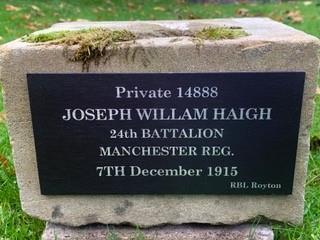
Charles Bridge died on 2 July 1917 from acute pulmonary TB and exhaustion aggravated by active service, aged 30. He was buried in Manchester (Phillips Park) Cemetery. His widow, Mary Ellen, and two of their four children lived at 13 Holbeck Street, Oldham Road. Commemoration refused as Charles Bridge was discharged after completing his medical.
Private 33217 George Thomas Nichols had been a builder’s labourer when he joined 27th Battalion at Ashton on 14 February 1916. He was discharged on 20 June 1916.
George Nichols died from TB aggravated by service and laryngeal exhaustion on 3 June 1920. He is buried in an unmarked grave at Delph Independent Chapelyard. His widow, Mary, lived at Bell Yard, Delph, Saddleworth. The couple had five children.

Private 28132 William Robert Clegg had worked in a cotton mill blowing room when he enlisted in 24th Battalion on 21 August 1915. William was a Boer War veteran, having previously served for twelve years in
The Reserve Battalions were re-designated as 69th – 71st Training Reserve at the beginning of September 1916. The Training Reserve was no longer part of the Manchesters; so many men from these Battalions received postings to other regiments when they had completed their training.
In October 1917 training for newly conscripted men developed again, returning to training with specific regiments and the creation of 51st and 52nd (Graduated) Battalions and 53rd (Young Soldier) Battalion. These were located in East Anglia with permanent staff who had generally returned from front line duty – see Samuel Keen above. These battalions served overseas in Germany after the Armistice.
Private 95659 George William Jones evidently enlisted with 3rd Battalion on 16 April 1918. He also served at home with 52nd Graduated Battalion prior to his discharge on 29 January 1919.
George Jones died on 12 March 1920, from pulmonary TB attributable to service, at 61 Haughton Road, Audenshaw, aged 19. A domestic motor car driver. The son of Mary Ann Jones who buried her son at Audenshaw Cemetery. Commemorated in UKBOR
17/12/2022
It has not been possible to identify which Battalion Private 79233 George Robert Banks trained with. He was discharged with a pension on 6 January 1919.

George Banks died from TB attributed to service on 6 April 1920, aged 20. He is buried at Salford (Agecroft) Cemetery. The son of Peter and Susannah Banks of 12 Clegg Street, Pendleton.
Garrison Battalions
Men determined as unfit for front line service but accepted for military duties began to be posted to the 1st Garrison Battalion (GB) when it was formed at Knowsley Park in September 1915. The Battalion embarked for India in February 1916 and 2nd GB was formed at Knowsley Park for further home service men.
Private 26530 George Conduit had been a gardener labourer when he enlisted in 19th Battalion on 5 June 1915. George had previously served six years in 8th Battalion. He was posted to 26th (Reserve) Battalion and 1st GB thereafter. George arrived in India with the Battalion on 25 February 1916 and later served in Singapore. George returned home in April 1919 and he was transferred to reserve on 3 May 1919.
George Conduit died from TB due to service on 12 December 1920, aged 43. He was buried at Manchester Southern Cemetery George’s widow, Edith, resided at 16 Garden Walk, Ardwick. The couple had two children. No headstone could be identified on the burial. Commemoration approved in UKBOR 29/10/2022
Company Sergeant Major 18387 Thomas Clark must have been a welcome addition to 22nd Battalion when he transferred from 4th Grenadier Guards in December 1914, previously enlisting as a guardsman on 9 September 1914. Having been discharged from the Grenadiers as a Company Sergeant Major (CSM) in 1913, Thomas had extensive service and he had been wounded in the Boer War.
Recognising his experience,
Thomas was promoted to CSM with E Company of 20th Battalion, as a mainstay for training the Pals for future overseas service.
It must have been determined that Thomas was unfit for duty on the Western Front. He was transferred to 1st GB on 6 September 1915 and embarked for India, where he served from 25 February 1916 until 24 February 1918. Thomas was discharged on 29 May 1918.
Thomas Clark died from TB due to service on 25 April 1919, aged 39. He was buried a Nottingham Church Cemetery. His widow, Kate Clark, and two children lived at 20 Tealby Terrace, Glebe Street, Nottingham. Commemoration approved in UKBOR 05/11/2022
Private 30663 John Thompson served in India, arriving as a reinforcement for 1st GB on 17 March 1916. John had enlisted in 11th South Lancashires and was posted to 21st (Reserve) Battalion of the King’s Liverpool Regiment, prior to his transfer to the Manchesters. John contracted malaria and returned home in June 1917. Posted to 3rd Battalion, John was discharged on 25 October 1917.
John Thompson died from malaria attributed to service and broncho pneumonia on 24 January 1921, aged 51. He is buried at St Helens Cemetery. In civilian life, John had been employed at Pilkingtons Glass factory. He was the husband of Jane Elizabeth, 6 Glover St, St Helens. The couple had four children.
Lance Sergeant 30511 Thomas Edward Clarke had previously served in the Liverpool Scottish when he enlisted in the 19th King’s Liverpool Regiment, 21747, on 13 November1914. He had been a ship’s purser prior to enlistment and served at home before transfer to 1st GB, Manchesters on 28 August 1915. Thomas was promoted corporal on 3 September and appointed lance sergeant 18 September 1915. He was attached to an aeroplane factory in Peterborough and posted to 2nd GB in January 1916 and Depot on 5 February 1916. Thomas was discharged on 11 July 1917.
Thomas died from pulmonary TB due to service and TB meningitis on 3 February 1918. He is buried in an unmarked grave at Liverpool (Anfield) Cemetery. His parents were Thomas and Emma Clarke of 176 Queens Road, Anfield, Liverpool.
Private 18495 Joseph Patrick Courtney had worked as a coach trimmer when he enlisted in 20th Battalion. He had previously served in the 3rd Militia Battalion of the Royal Dublin Fusiliers. Joseph was posted to 26th Battalion, later transferred to 1st and subsequently 2nd GBs. He was discharged at Prescott on 14 April 1916.
Joseph Courtney died at Salford Union Infirmary from bronchitis, emphysema and pulmonary congestion aggravated by service with cardiac muscle failure on 6 June 1916, aged 31. Joseph was buried at Moston (St. Joseph's) Roman Catholic Cemetery. Joseph’s widow, Elizabeth, with four children lived at 5 Fildes Street, Broughton. No headstone could be identified on Joseph’s grave.
Pte 79233 George Robert Banks had been a waggoner in a coal mine prior been conscripted into the Regiment. Records do not identify which Battalion he served with and George did not qualify for the Great War service medals. He may have served in the British Army of Occupation in Germany, prior to his discharge with pulmonary TB attributable to service on 6 January 1919.
George Banks died at home from TB on 6 April 1920, aged 20. The son of Peter & Susannah Banks, 12 Clegg Street, Pendleton. Records indicate he is buried in a Salford City cemetery.
As a general reservation, the actual commemorations may be found to be different than anticipated. CWGC will decide the most appropriate steps.


